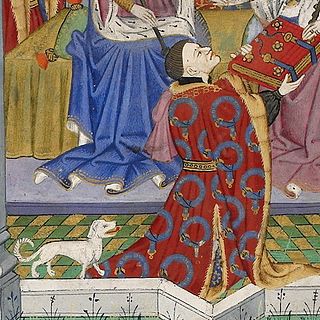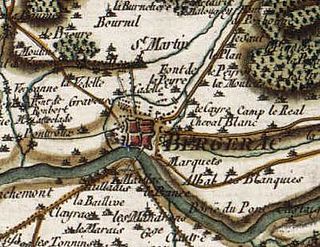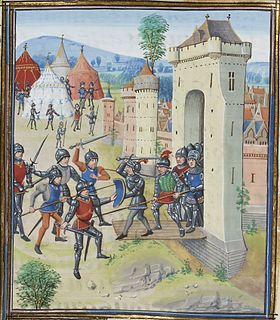
John Beaufort, 1st Duke of Somerset was an English nobleman and military commander during the Hundred Years' War.

John Talbot, 1st Earl of Shrewsbury, 1st Earl of Waterford, 7th Baron Talbot, KG, known as "Old Talbot", was an English nobleman and a noted military commander during the Hundred Years' War. He was the most renowned in England and most feared in France of the English captains in the last stages of the conflict. Known as a tough, cruel, and quarrelsome man, Talbot distinguished himself militarily in a time of decline for the English. Called the "English Achilles" and the "Terror of the French", he is lavishly praised in the plays of Shakespeare. The manner of his death, leading a charge against artillery, has come to symbolize the passing of the age of chivalry. He also held the subsidiary titles of 10th Baron Strange of Blackmere and 6th Baron Furnivalljure uxoris.

The Battle of Castillon was a battle fought on 17 July 1453 in Gascony near the town of Castillon-sur-Dordogne, between England and France. It was a decisive French victory and is considered to mark the end of the Hundred Years' War.

Jean Bureau was a French artillery commander active primarily during the later years of the Hundred Years' War. Along with his brother, Gaspard, he is credited with making French artillery the most effective in the world. As Master Gunner of Artillery in the armies of Charles VII, Bureau acquired a reputation as an effective artillery officer during the Normandy campaign (1449–1450), when his bombardments helped capture the towns of Rouen, Harfleur, and Honfleur, and aided in the French victory at Formigny. Bureau commanded the victorious French army at the decisive Battle of Castillon in 1453.

The Battle of Auberoche was fought on 21 October 1345 during the Gascon campaign of 1345 between an Anglo-Gascon force of 1,200 men under Henry, Earl of Derby, and a French army of 7,000 commanded by Louis of Poitiers. It was fought at the village of Auberoche near Périgueux in northern Aquitaine. At the time, Gascony was a territory of the English Crown and the "English" army included a large proportion of native Gascons. The battle resulted in a heavy defeat for the French, who suffered very high casualties, with their leaders killed or captured.
This is a timeline of the Hundred Years' War between England and France from 1337 to 1453 as well as some of the events leading up to the war.
John Talbot, 1st Baron Lisle and 1st Viscount Lisle, English nobleman and medieval soldier, was the son of John Talbot, 1st Earl of Shrewsbury, and his second wife Margaret Beauchamp.

The Lancastrian War was the third and final phase of the Anglo-French Hundred Years' War. It lasted from 1415, when King Henry V of England invaded Normandy, to 1453, when the English lost Bordeaux. It followed a long period of peace from the end of the Caroline War in 1389. The phase was named after the House of Lancaster, the ruling house of the Kingdom of England, to which Henry V belonged.
Events from the 1450s in England.

Castillon-la-Bataille is a commune in the Gironde department in Nouvelle-Aquitaine in southwestern France.

The Hundred Years' War was a series of conflicts in Western Europe from 1337 to 1453, waged between the House of Plantagenet and its cadet House of Lancaster, rulers of the Kingdom of England, and the House of Valois over the right to rule the Kingdom of France. It was one of the most notable conflicts of the Middle Ages, in which five generations of kings from two rival dynasties fought for the throne of the largest kingdom in Western Europe. The war marked both the height of chivalry and its subsequent decline, and the development of stronger national identities in both countries.

The Battle of Bergerac was fought between Anglo-Gascon and French forces at the town of Bergerac in Gascony, in August 1345 during the Hundred Years' War. In early 1345 Edward III of England decided to launch a major attack on the French from the north, while sending smaller forces to Brittany and Gascony, the latter being both economically important to the English war effort and the proximate cause of the war. The French focused on the threat to northern France, leaving comparatively small forces in the south west.
Jean de Foix was the Captal de Buch, first Earl of Kendal, Vicomte de Castillon, Meilles and Comte de Benauges.

Gaston I de Foix-Grailly was from 1412 to 1451 Captal de Buch, Count of Bénauges, and Viscount Castillon. He was a Knight of the Order of the Garter from 1438. Gaston was the second son and heir of Archambaud de Grailly and his wife, Isabella, Countess of Foix.

The Gascon campaign of 1345 was conducted by Henry, Earl of Derby, as part of the Hundred Years' War. The whirlwind campaign took place between August and November 1345 in Gascony, an English-controlled territory in south-west France. Derby, commanding an Anglo-Gascon force, oversaw the first successful English land campaign of the war. He twice defeated large French armies in battle, taking many noble and knightly prisoners. They were ransomed by their captors, greatly enriching Derby and his soldiers in the process. Following this campaign, morale and prestige swung England's way in the border region between English-occupied Gascony and French-ruled territory, providing an influx of taxes and recruits for the English armies. As a result, France's ability to raise tax money and troops from the region was much reduced.

The Siege of Aiguillon, an episode in the Hundred Years' War, began on 1 April 1346 when a French army commanded by John, Duke of Normandy, laid siege to the Gascon town of Aiguillon. The town was defended by an Anglo-Gascon army under Ralph, Earl of Stafford.

Lancaster's chevauchée of 1346 was a series of offensives directed by Henry, Earl of Lancaster, in southwestern France during autumn 1346, as a part of the Hundred Years' War.

The Black Prince's chevauchée of 1356, which began on 4 August at Bordeaux and ended with the Battle of Poitiers on 19 September, was a devastating raid of Edward of Woodstock, Prince of Wales, the eldest son of King Edward III of England. This expedition of the Black Prince devastated large parts of Bergerac, Périgord, Nontronnais, Confolentais, Nord-Ouest, Limousin, La Marche, Boischaut, Champagne Berrichonne, Berry, Sologne, south of Touraine and Poitou.
Events from the year 1453 in France.

The Black Prince's chevauchée, also known as the grande chevauchée, was a large-scale mounted raid carried out by an Anglo-Gascon force under the command of Edward, the Black Prince, between 5 October and 2 December 1355 as a part of the Hundred Years' War. John, Count of Armagnac, who commanded the local French forces, avoided battle, and there was little fighting during the campaign.












